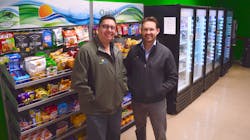Aaron Lawton fell in love with vending 16 years ago. It lets him be part of the life blood of the community as he visits businesses throughout his service area in Boise, ID. When he saw a micro market for the first time, he saw a way to answer all the requests consumers had with vending. He jumped all in, including pushing the micro market model further in 2018 with a hybrid cafe/micro market concept.
A career through serendipity
Lawton came to the vending industry by accident. He had purchased a few residential rental properties with plans to expand. He applied to be a route driver as a side job that allowed him evenings that he could dedicate to property management. It wasn’t long before two things became clear.
“I found out I hated the residential rental business,” Lawton said. “But I loved being a route driver.”
The ability to go into his community and interact with people at various jobs drew him in. “I love visiting different businesses,” he said, “going from a hospital to a blue-collar break room to a lawyer’s office in one day. What other job lets you do that?”
Lawton sold off his properties and turned his attention to making a career in vending. “I went to the management of the vending division I was a driver for and said I wanted to lead the division. I wanted to sell vending and expand the operation,” Lawton said.
Over the next 12 years, Lawton grew the vending division of the foodservice company from one route to more than five. It became so successful that the foodservice company would later be able to sell it to Canteen. After more than a decade at the company, Lawton wanted to expand into a new, emerging technology that he had seen firsthand at a mentor’s Salt Lake City, UT operation — micro markets. However, his company then declined several large vending contracts, and opted not to invest in the micro market concept.
“Vending made up only 1 percent of the revenue for this foodservice company,” explained Lawton. “Our small division wasn’t their primary focus.”
Lawton believed in the micro market concept so strongly that he decided to leave his position and go out on his own. He told the foodservice company and even offered to buy their entire vending division, although the sale didn’t come to fruition.
Launching a new business
Lawton founded Oasis Northwest in December of 2013. “I built the business with micro markets as the primary focus,” he said. He jumped into the solution immediately, deciding on a provider he had researched while working for the foodservice company. It had a reasonable cost of entry and wasn’t competing with independents the way some other suppliers were. He added micro markets quickly under the new system and it was exactly what his area needed.
He was adding a market every few weeks with eight by 2014 when his company experienced some growing pains. Lawton educated himself on some of the other suppliers with a good idea of what he now needed in a micro market system that would grow with his company. He invested in Three Square Market, eventually converting older locations to Three Square, so all 22 of his micro markets would be on the same system.
“Operationally, Three Square works better for the way we operate,” Lawton explained. He has the warehouse set up in accordance with how Three Square prekitting is organized, including each item being alphabetical within a category.
“Some software exports with a random flow to how orders are printed. With Three Square, it’s alphabetical, so for example, ‘Almond Joy’ is first in the list,” he said. This helps Lawton set up his warehouse space efficiently. He prekits the micro market orders with assistance from his other two employees, Art Gonzalez, a full-time driver and technician who followed Lawton from the foodservice company, and one full-time person who splits time between deliveries and warehouse work.
Lawton also appreciates how Three Square makes bookkeeping easier with online access. He can perform tasks such as inventory adjustments from home. “It’s nice to see the people I care about even if I’m behind a laptop,” Lawton joked about the flexibility the online system gives him.
From an end-user standpoint, Three Square offers consumers chip-enabled card payments and acceptance of Google and Apple Pay. Three Square also offers Lawton all the displays, coolers and accessories for the micro market, not just the kiosk and back-end software. “We have so far used our point-of-sale operator [Three Square] for everything,” Lawton said. It’s easier. We can go to the lending company and ask for just one check.”
Regular service and fresh food
Lawton creates the service schedule for his micro markets based on how much fresh food goes to each. Because the food is made locally it has a shorter shelf life and needs to be refreshed more often. “Our average micro market’s minimum service is twice a week,” said Lawton. “However, many of the micro markets get serviced up to 6 times a week.” Contributing factors that can affect the level of service for Lawton include the number of employees at the location and the hours employees work. “A 24-hour warehouse or call center usually needs more than an 8 to 5 location might,” said Lawton.
He has also tried non-food locations as a way to meet the demands of smaller locations (those fewer than 100 employees); however, it hasn’t been a tremendous success yet. “Eventually I think we and the industry will get there,” Lawton said. He believes that market saturation will make it necessary or operators will recycle down, as many operators did with vending machines, putting older micro market displays in smaller locations during upgrades and renovations to larger ones.
Lawton does offer some vending machines in public venues and smaller accounts. He also provides coffee services to 25 locations, mostly drip brewers, but he has a few bean-to-cup machines placed in micro markets. “We have several Cafection machines in markets,” said Lawton. “They make a great cup of coffee.” The most recent have a receipt printer the customer can carry over to the kiosk and scan. If it’s an older model, Lawton does a coffee day where he can educate customers on using the touchscreen to search for the coffee type and size, plus hand out samples of free coffee, boosting interest in the market machine.
One driver, multiple services
No matter what type of service is provided to a location Lawton wants there to be only one point of contact. Water, coffee, vending, micro market — it’s all on one vehicle. “I’ve always felt it was important to have one driver per account — they are a representative of the company,” said Lawton. He knows there are different philosophies regarding service, but he believes if a customer has a single point of contact than they become part of the culture. “The company trusts them, relies on the driver to provide service to them,” Lawton explained.
Realizing the hybrid concept
Lawton knew micro markets were going to be the future of vending, but he wasn’t about to stop there. As an employee of a foodservice company for years he saw terrific food being provided to employees at worksites. He had tried to incorporate this into vending machines, but it never worked. “The perception was — it’s just vending,” said Lawton. “No matter what we did it never worked.” Micro markets helped but they still don’t offer some of the advantages of an onsite foodservice facility. Then opportunity came knocking.
“They were building a medical school and the company we partnered with to create our micro market food suggested the potential of a hybrid instead of just a market.”
Lawton saw its success at once. This large facility would have lots of people, staff and employees, onsite all day, looking for convenient food items. It could also be partially staffed in order to draw customers into the space. The hybrid was born.
The hybrid location features an open-air cooler that highlights the locally made food. However, it is staffed for 8 hours a day by a barista. She has a cash drawer tied to the micro market kiosk. “If they want, they can check out with her, their food and latte, all with their market account,” said Lawton. “Or it’s possible to skip the line and use the self-checkout instead.”
At the end of the day, the barista shuts down the espresso side and the cash drawer. It then operates like a traditional micro market allowing access to nourishment at all hours. “The pilot has been so good that we are analyzing the numbers to see where else we can place one,” Lawton added. \
Poised for growth
Now that Lawton has a micro market system that can grow with his business, it’s time to address some physical growing pains.
“We are at capacity,” said Lawton. “We are bursting at the seams in our warehouse so are looking to move to a 3,000-square-foot facility,” he said.
Oasis Northwest is also at capacity for its food truck. “We are at the limit and looking at what’s next,” Lawton said. He is considering a vehicle with refrigerated compartments rather than a fully refrigerated truck as it better suits his one driver for all services model. Lawton continues to love the industry and is excited about what micro markets bring to the table. He plans to continue serving his business partners, bringing a great attitude to work each day and exciting solutions to the break room for Boise residents.
Combatting Theft
Like all micro market operators, Aaron Lawton, founder of Oasis Northwest, has to deal with theft. While each location is different, his average shrinkage rate hovers at 2 percent. The best locations have management who stress to employees how much they stand to lose by stealing. “They will tell them ‘You will lose your job if you steal a Snickers bar,’“ Lawton said. “It’s really about building a culture that appreciates the market and therefore stays honest.” Lawton has had the clients hang signs about the micro market being a privilege. If theft is too high, they will go back to vending. That stops the increase in shrinkage.
Operation Profile
Oasis Northwest
Founder: Aaron Lawton
Location: Boise, ID
Year founded: 2013
No. of micro markets: 22
No. of employees: 3
Micro market supplier: Three Square Market
About the Author

Emily Refermat
Emily Refermat began covering the vending industry in 2006 and served as editor of Automatic Merchandiser from 2012 to 2019. To reach the current editor of Automatic Merchandiser and VendingMarketWatch.com, email [email protected].
